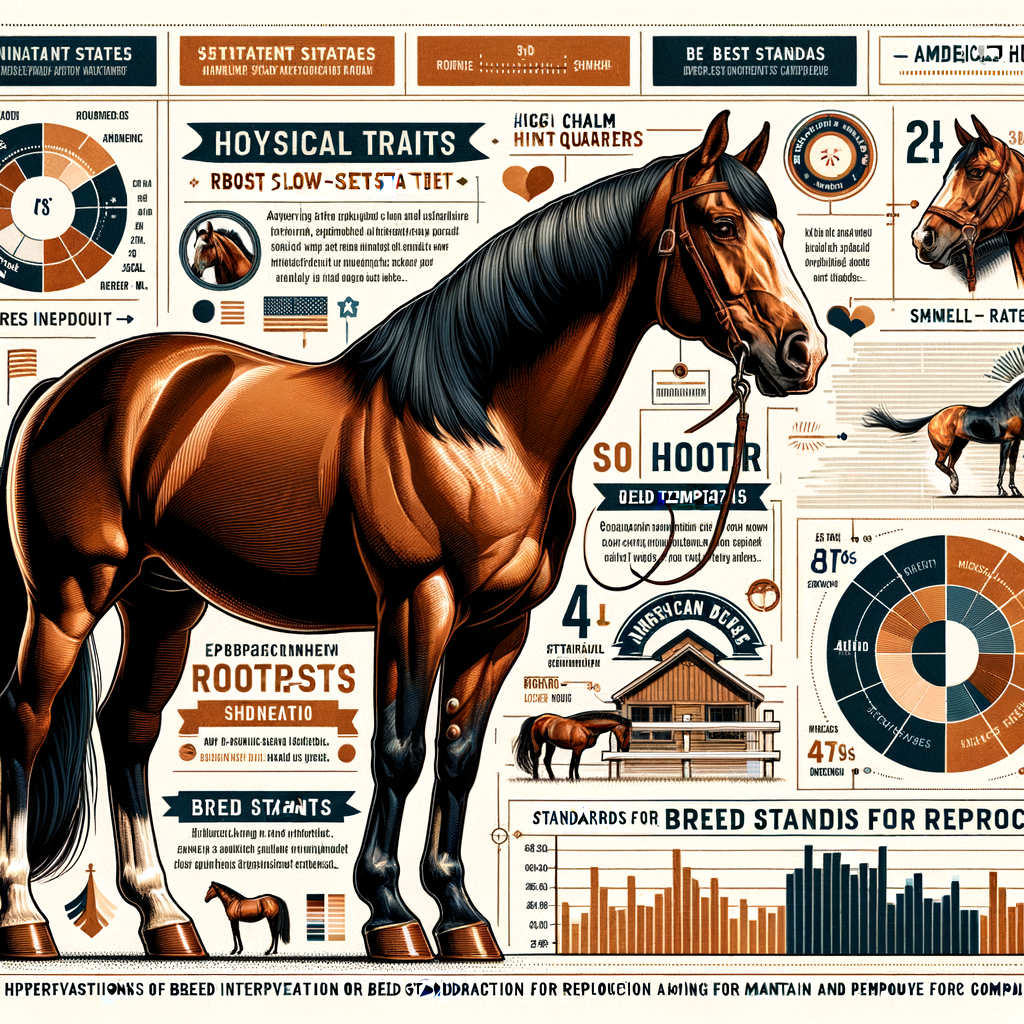
Introduction to the American Quarter Horse Breed
The American Quarter Horse is a breed that holds a special place in the heart of the United States. Known for its speed, agility, and versatility, this breed has made significant contributions to American history and culture. In this section, we will delve into an overview of the Quarter Horse breed and its significance in American history.
- Overview of the Quarter Horse breed
- Significance of the Quarter Horse in American history
The American Quarter Horse, often simply referred to as a Quarter Horse, is one of the oldest recognized breeds in the United States. It is named for its exceptional ability to outrun other horse breeds in races of a quarter mile or less. This breed is renowned for its muscular build, compact body, and fast sprinting speed. They are also known for their calm and docile temperament, making them a favorite among horse lovers and equestrians.
The Quarter Horse has played a pivotal role in the history of America. In the early days, these horses were used for transportation, farming, and cattle herding. They were the preferred breed of the cowboys in the Wild West due to their speed, agility, and ability to make quick, sharp turns. The Quarter Horse also played a significant role in the American Revolutionary War, serving as war horses due to their endurance and speed. Today, they continue to be a symbol of American heritage and are often seen in rodeos, horse shows, and racing events.
In the following sections, we will explore more about the characteristics, history, and breeding standards of the American Quarter Horse. Join us as we delve deeper into the majesty of this remarkable breed.
Understanding Quarter Horse Characteristics
One of the most popular horse breeds in the United States is the American Quarter Horse. Known for its speed, agility, and versatility, the Quarter Horse has unique physical characteristics that set it apart from other breeds. Let’s delve into the physical traits of the Quarter Horse to understand what makes this breed so special.
Physical Traits of the Quarter Horse
The physical traits of the Quarter Horse are as distinctive as they are fascinating. These traits are not just for show; they contribute to the breed’s performance in various activities, from racing to ranch work. Let’s explore these traits in detail.
- Detailing the Quarter Horse conformation
- Unique physical traits of the Quarter Horse breed
The Quarter Horse has a well-muscled body, particularly in the hindquarters, which gives it the power and speed it’s famous for. The breed typically stands between 14 and 16 hands high (a hand is a unit of measurement in equestrian terms, equal to about 4 inches), making it a medium-sized horse. The head is finely chiseled with a broad forehead, and the eyes are large and expressive. The neck is strong and muscular, leading to a deep chest and short back. The legs are sturdy, with hard, well-shaped hooves.
One of the most unique physical traits of the Quarter Horse is its powerful hindquarters, which are larger and more muscular than those of most other breeds. This characteristic gives the Quarter Horse its exceptional speed over short distances. Another distinctive trait is the breed’s compact and balanced body structure, which contributes to its agility and versatility. The Quarter Horse also has a calm and intelligent expression, reflecting its gentle temperament and keen intelligence.
In conclusion, the Quarter Horse’s physical characteristics, from its muscular conformation to its unique traits, contribute to its reputation as a versatile and high-performing breed. Whether it’s racing, working on a ranch, or simply being a companion animal, the Quarter Horse excels in every role, thanks to its distinctive physical traits.
Quarter Horse Temperament
When it comes to the American Quarter Horse, their temperament is as unique as their physical traits. Let’s delve into the specifics of their character and how it contributes to their versatility.
- General temperament of the Quarter Horse breed
- How temperament influences the Quarter Horse’s versatility
The Quarter Horse is renowned for its calm and steady demeanor. This breed is known for its intelligence and willingness to please, making it a favorite among horse enthusiasts of all ages. They are friendly, docile creatures that are easy to train and handle. Their patient and gentle nature makes them ideal for beginners and experienced riders alike.
The temperament of the Quarter Horse significantly contributes to its versatility. Their calm demeanor, combined with their intelligence, makes them adaptable to various riding styles and disciplines. Whether it’s for trail riding, racing, or working in a ranch, the Quarter Horse’s temperament allows it to excel in different environments.
For instance, their patience and gentleness make them perfect for therapeutic riding programs. Their intelligence and eagerness to please make them excellent at tasks such as herding cattle or performing in horse shows. This adaptability is one of the reasons why the Quarter Horse is one of the most popular breeds in the United States.
In conclusion, the Quarter Horse’s temperament is a key factor in its versatility and popularity. Their calm, intelligent, and eager-to-please nature makes them suitable for a variety of tasks and environments, making them a beloved breed among horse lovers.
Exploring the History of the Quarter Horse
Delving into the history of the Quarter Horse breed takes us on a fascinating journey. This breed has a rich and varied past that has shaped it into the horse we know and admire today. Let’s explore the origins and evolution of the Quarter Horse.
- Origins of the Quarter Horse breed
- Evolution of the Quarter Horse over the centuries
The Quarter Horse breed traces its roots back to the 1600s in America. The breed was developed by settlers who needed a horse that was versatile, sturdy, and fast. They crossed English Thoroughbreds with native horses, resulting in a breed that was not only quick over short distances (hence the name ‘Quarter Horse’), but also had the strength and endurance to work on farms and ranches.
Over the centuries, the Quarter Horse has evolved to meet changing needs and environments. In the 19th century, these horses were used in cattle drives and as war mounts. They were prized for their agility, speed, and ability to handle rough terrain. In the 20th century, with the advent of mechanization, the Quarter Horse found new roles in rodeo events, horse shows, and as a family horse.
Today, the Quarter Horse is the most popular breed in the United States, with over 3 million registered with the American Quarter Horse Association. This breed’s history is a testament to its adaptability, resilience, and enduring appeal.
| Century | Role of the Quarter Horse |
|---|---|
| 17th-18th Century | Work horse on farms and ranches |
| 19th Century | Used in cattle drives and as war mounts |
| 20th Century | Participated in rodeo events, horse shows, and served as a family horse |
| 21st Century | Most popular breed in the United States |
Understanding the history of the Quarter Horse gives us a deeper appreciation for this remarkable breed. It’s a history marked by adaptability, versatility, and the ability to excel in a variety of roles. The Quarter Horse truly is a breed for all seasons.
Decoding Quarter Horse Breed Standards
Understanding the breed standards of the American Quarter Horse is crucial for breeders, horse enthusiasts, and potential owners. These standards provide a clear guideline on what to expect and look for in a Quarter Horse.
Official Breed Standards
The official breed standards for the American Quarter Horse are set by the American Quarter Horse Association (AQHA). These standards are designed to maintain the breed’s integrity and ensure its continued success.
- Defining the official Quarter Horse breed standards
- Importance of adhering to breed standards
The official breed standards of the Quarter Horse focus on several key areas. These include the horse’s physical characteristics, temperament, and performance abilities. Physically, a Quarter Horse should have a small, short, refined head with a straight profile, and strong, well-muscled body, with a broad chest and powerful, rounded hindquarters. They should stand between 14 and 16 hands high and can come in any solid color, with the most common being sorrel, a kind of reddish-brown. In terms of temperament, Quarter Horses are known for their calm, steady, and versatile nature. They are also renowned for their speed, particularly over short distances, hence the name ‘Quarter’ Horse.
Adhering to breed standards is important for several reasons. Firstly, it ensures the quality and consistency of the breed. This is particularly important for breeders, as it allows them to predict with some certainty the likely characteristics and abilities of any offspring. Secondly, breed standards help to protect the health of the breed. By promoting a standard that includes a strong, well-muscled body and good overall balance, the AQHA encourages breeding practices that are likely to produce healthy, robust animals. Finally, breed standards are important for maintaining the breed’s history and heritage. The Quarter Horse has a rich history, and each individual horse is a part of that history. By adhering to breed standards, breeders and owners can help to preserve that history for future generations.
Common Variations in the Breed
As we delve deeper into the world of Quarter Horses, it’s important to understand that like any other breed, there are common variations that exist. These variations, primarily genetic, play a significant role in the breed’s characteristics and abilities.
- Exploring common variations in Quarter Horse genetics
Quarter Horses are known for their versatility, and this is largely due to the genetic variations within the breed. Some of the most common variations include color, size, and muscle composition.
| Genetic Variation | Description |
|---|---|
| Color | Quarter Horses come in a variety of colors, including bay, black, chestnut, dun, gray, grullo, palomino, red dun, roan, and sorrel. |
| Size | The size of a Quarter Horse can vary, with some standing as short as 14 hands high (hh) and others reaching up to 16hh. |
| Muscle Composition | Some Quarter Horses are bred for speed, resulting in a leaner muscle composition, while others are bred for work, leading to a more muscular build. |
- How these variations impact the breed
These genetic variations significantly impact the breed in several ways. For instance, the color of a Quarter Horse can influence its popularity and price in the market. The size of the horse can determine its suitability for certain tasks or sports. For example, taller horses are often preferred for jumping disciplines, while shorter, more muscular horses are ideal for tasks that require strength and agility, like cattle work.
The muscle composition of a Quarter Horse can also dictate its performance in various equestrian events. Horses with a leaner muscle composition are typically faster and more suited for racing, while those with a more muscular build excel in events that require power and endurance, such as reining or cutting.
In conclusion, understanding these common variations in Quarter Horse genetics is crucial for breeders, owners, and enthusiasts alike. It allows for a deeper appreciation of the breed’s diversity and adaptability, and aids in making informed decisions when it comes to breeding, purchasing, or training these remarkable horses.
Insights into Breeding Quarter Horses
As we delve deeper into the world of Quarter Horses, it’s essential to understand the intricacies of breeding these magnificent creatures. Breeding Quarter Horses is a science and an art, requiring a deep understanding of various factors and the role of genetics.
- Essential factors to consider when breeding Quarter Horses
- Health Status: Ensuring the health of both the mare and the stallion is paramount. Regular veterinary check-ups can help identify any potential health issues early.
- Age: The age of the horses involved in breeding is crucial. Mares are typically most fertile between the ages of 3 and 15, while stallions can remain fertile for much longer.
- Temperament: The temperament of the horses can also play a role in successful breeding. Calm, well-adjusted horses tend to breed more successfully.
- Physical Characteristics: Breeders often aim to enhance specific physical traits in their offspring, such as muscularity, speed, or agility. Therefore, choosing horses with these desired traits is essential.
- Role of genetics in breeding Quarter Horses
When it comes to breeding Quarter Horses, several key factors come into play. These include:
Genetics plays a significant role in breeding Quarter Horses. Understanding the basics of equine genetics can help breeders make informed decisions and predict the likely traits of the offspring.
For example, the color of a Quarter Horse is determined by its genes. Some colors, like chestnut, are dominant, meaning that if a horse has even one chestnut gene, it will be chestnut. Other colors, like black, are recessive, meaning a horse needs two black genes to be black.
Genetics also influences the horse’s physical traits and abilities. For instance, some genes may contribute to a horse’s speed, agility, or endurance. By understanding these genetic factors, breeders can select the best horses for breeding to produce high-quality offspring.
In conclusion, breeding Quarter Horses is a complex process that requires a deep understanding of various factors and the role of genetics. By considering these elements, breeders can produce healthy, high-quality horses that embody the best traits of the Quarter Horse breed.
Conclusion: The Majesty of the Quarter Horse Breed
As we draw our exploration of the Quarter Horse breed to a close, we can’t help but marvel at the unique attributes and rich history that make this breed truly majestic. Let’s take a moment to recap what we’ve learned and reflect on why the Quarter Horse continues to be a beloved breed among horse enthusiasts worldwide.
- Recap of the Quarter Horse breed information
- Why the Quarter Horse is a beloved breed
The American Quarter Horse, known for its speed, agility, and friendly disposition, has a fascinating history that dates back to the 1600s. Characterized by its muscular build and compact body, the Quarter Horse is a versatile breed that excels in a variety of disciplines, from racing and rodeo events to work on ranches and farms.
As per the breed standards, the Quarter Horse stands between 14.3 and 16 hands high and can weigh anywhere from 950 to 1,200 pounds. The breed comes in a variety of colors, with the most common being sorrel, a reddish-brown hue. The Quarter Horse’s unique characteristics, combined with its gentle nature and intelligence, make it an ideal choice for both novice and experienced riders.
The Quarter Horse’s popularity stems not only from its physical attributes but also from its remarkable temperament. Known for their calm and steady nature, Quarter Horses are often described as “people-oriented,” forming strong bonds with their human companions. Their versatility and adaptability make them suitable for a wide range of activities, from competitive sports to leisure riding.
Moreover, the Quarter Horse’s resilience and hardiness, inherited from its ancestors who worked long hours on American farms and ranches, add to its appeal. These horses are not just beautiful and strong; they are also reliable and hardworking, embodying the spirit of the American West.
In conclusion, the Quarter Horse breed, with its rich history, distinct characteristics, and endearing temperament, truly stands out in the equine world. Its majesty lies not just in its physical prowess but also in its unwavering spirit and enduring charm. Whether you’re a horse lover, a rider, or simply an admirer of these noble creatures, the Quarter Horse is sure to capture your heart.









